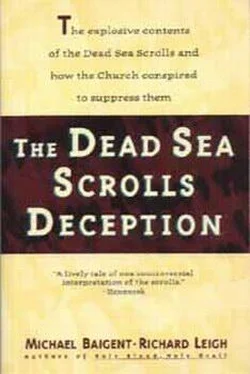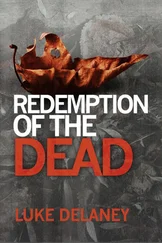Quoting Hegesippus, Eusebius states that James ‘the Righteous’ ‘was holy from his birth’:
he drank no wine… ate no animal food; no razor came near his head; he did not smear himself with oil, and took no baths. He alone was permitted to enter the Holy Place [the Holy of Holies in the Temple], for his garments were not of wool but of linen [i.e. priestly robes]. He used to enter the Sanctuary alone, and was often found on his knees beseeching forgiveness for the people, so that his knees grew hard like a camel’s… Because of his unsurpassable righteousness, he was called the Righteous and… ‘Bulwark of the people’… 12
At this point, it is worth interrupting the text to note certain intriguing details. James is said to wear linen, or priestly robes. This was the prerogative of those who served in the Temple and belonged to one of the priestly families, traditionally the Sadducean ‘aristocracy’ who, during the 1st century, came to an accommodation with Rome and the Herodian dynasty of Roman puppets. Again, Eisenman points out, Epiphanius, another Church historian, speaks of James wearing the mitre of the high priest. 13Then, too, only the high priest was allowed to enter the Holy of Holies, the inner sanctum and most sacred spot in the Temple. What, then, can James be doing there — and without eliciting any explanation or expression of surprise from Church historians, who seem to find nothing untoward or irregular in his activities? Did he, perhaps, by virtue of his birth, have some legitimate right to wear priestly apparel and enter the Holy of Holies? Or might he have been acting, as Eisenman suggests, in the capacity of a kind of ‘opposition high priest’ — a rebel who, defying the established priesthood’s accommodation with Rome, had taken upon himself the role they had betrayed? 14Certainly the established priesthood had no affection for James. According to Hegesippus, the ‘Scribes and Pharisees’ decide to do away with him, so that the people ‘will be frightened and not believe him’. They proclaim that ‘even the Righteous one has gone astray’, 15and invoke a quote from the Old Testament — in this case from the prophet Isaiah (Isa. 3:10) — to justify their actions. They note that Isaiah had prophesied the death of the ‘Righteous One’. In murdering James, therefore, they will simply be bringing Isaiah’s prophecy to fulfilment. But also, in using this quote from Isaiah, they are following a technique employed in both the Dead Sea Scrolls and the New Testament. Eisenman points out that, just as this quote is used in order to describe the death of James, so the Qumran community employs similar ‘Righteousness’ passages from the New Testament in order to describe the death of the ‘Teacher of Righteousness’. 16Eusebius goes on to describe the death of James in the following manner:
So they went up and threw down the Righteous one. They said to each other ‘let us stone James the Righteous’, and began to stone him, as in spite of his fall he was still alive… While they pelted him with stones… [a member of a particular priestly family] called out: ‘Stop! What are you doing…’ Then one of them, a fuller, took the club which he used to beat clothes, and brought it down on the head of the Righteous one. Such was his martyrdom… Immediately after this Vespasian began to besiege them. 17
Vespasian, who became emperor in AD 69, commanded the Roman army that invaded Judaea to put down the revolt of ad 66. Here again, then, is a chronological connection between James’s death and the revolt. But Eusebius goes further. The connection for him is more than just chronological. The entire ‘siege of Jerusalem’, he says, meaning presumably the whole of the revolt in Judaea, was a direct consequence of James’s death — ‘for no other reason than the wicked crime of which he had been the victim’. 18
To support this startling contention, Eusebius invokes Josephus. The passage of Josephus he quotes, although no longer to be found in any extant version of Josephus, was unquestionably what Josephus wrote, because Origen, one of the earliest and most prolific of the Church Fathers, quotes precisely the same passage. Referring to the revolt of AD 66 and the Roman invasion that followed, Josephus states that ‘these things happened to the Jews in requital for James the Righteous, who was a brother of Jesus known as Christ, for though he was the most righteous of men, the Jews put him to death’. 19
From these fragments pertaining to James, a scenario begins to take form. James, the acknowledged leader of the ‘early Church’ in Jerusalem, represents a faction of Jews who, like the Qumran community, are ‘zealous for the Law’. This faction is understandably hostile towards the Sadducee priesthood and the high priest Ananas (appointed by Herod 20), who have betrayed their nation and their religion by concluding an accord with the Roman administration and its Herodian puppet-kings. So intense is this hostility that James arrogates to himself the priestly functions which Ananas has compromised. 21Ananas’ supporters respond by contriving James’s death. Almost immediately thereafter, the whole of Judaea rises in revolt, and Ananas is himself one of the first casualties, assassinated as a pro-Roman collaborator. As the rebellion gains momentum, Rome is forced to react, and does so by dispatching an expeditionary force under Vespasian. The result is the war which witnesses the sack of Jerusalem and the destruction of the Temple in AD 68, and which does not end until the fall of Masada in AD 74.
The only uncertain element in this scenario is the nature and magnitude of the part played by James’s death. Did it merely coincide chronologically? Or was it, as Josephus and Eusebius assert, the primary causal factor? The truth, almost certainly, lies somewhere in between: the revolt stemmed from enough contributing factors for the historian not to have had to fall back on James’s de2th as a sole explanation. On the other hand, the evidence unquestionably indicates that James’s death was not just a marginal incident. It would seem to have had at least something to do with the course of public events.
In any case James, as a result of Eisenman’s analysis, indubitably emerges as a more important personage in 1st-century history than Christian tradition has hitherto acknowledged. And the ‘early Church’ emerges in a very different light. It is no longer a congregation of devotees eschewing politics and public affairs, pursuing a course of personal salvation and aspiring to no kingdom other than that of heaven. On the contrary, it becomes one of the manifestations of Judaic nationalism at the time — a body of militant individuals intent on upholding the Law, deposing the corrupt Sadducee priesthood of the Temple, toppling the dynasty of illegitimate puppet-kings and driving the occupying Romans from the Holy Land. In all these respects, it conforms to conventional images of the Zealots.
But what has all this to do with Qumran and the Dead Sea Scrolls?
From the Acts of the Apostles, from Josephus and from early Christian historians, there emerges a coherent, if still incomplete, portrait of James, ‘the Lord’s brother’. He appears as an exemplar of’righteousness’ — so much so that ‘the Just’, or ‘the Righteous’, is appended as a sobriquet to his name. He is the acknowledged leader of a ‘sectarian’ religious community whose members are ‘zealous for the Law’. He must contend with two quite separate and distinct adversaries. One of these is Paul, an outsider who, having first persecuted the community, then converts and is admitted into it, only to turn renegade, prevaricate and quarrel with his superiors, hijack the image of Jesus and begin preaching his own doctrine — a doctrine which draws on that of the community, but distorts it. James’s second adversary is from outside the community — the high priest Ananas, head of the Sadducee priesthood. Ananas is a notoriously corrupt and widely hated man. He has also betrayed both the God and the people of Israel by collaborating with the Roman administration and their Herodian puppet-kings. James publicly challenges Ananas and eventually meets his death at the hands of Ananas’ minions; but Ananas will shortly be assassinated in turn. All of this takes place against a backdrop of increasing social and political unrest and the impending invasion of a foreign army.
Читать дальше












